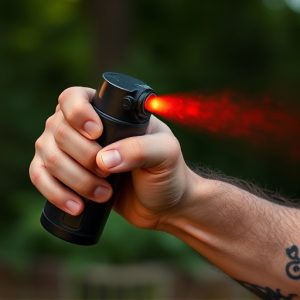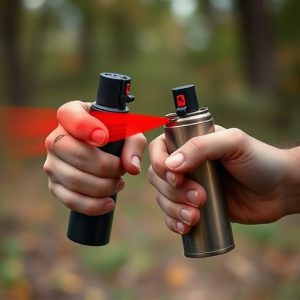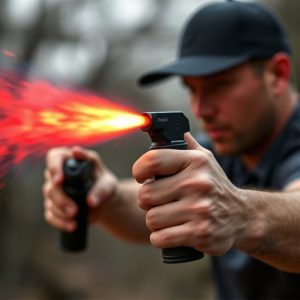Spray and Move Deployment: Effective Crowd Control Strategies
Pepper spray, particularly through the "Spray and Move" deployment strategy, is a globally…….
Pepper spray, particularly through the "Spray and Move" deployment strategy, is a globally employed tool for law enforcement in high-pressure crowd control scenarios. This tactic involves strategically spraying individuals at the forefront of crowds to create separation from officers, de-escalate tensions, and facilitate safe dispersal without causing prolonged disruption or harm to bystanders. Effectiveness hinges on rigorous training, disciplined execution, and adherence to legal standards. While effective, there's a growing emphasis on exploring alternative, less invasive methods that prioritize safety and minimize harm, such as non-lethal weapons and drone surveillance, to enhance traditional crowd control techniques.
In recent years, pepper spray has emerged as a prominent tool in crowd control strategies employed by law enforcement worldwide. This article delves into the multifaceted world of this powerful tool, exploring its mechanics, deployment techniques like the effective ‘Spray and Move’ strategy, and its strategic use cases. We also dissect critical safety considerations, training protocols, and alternative crowd management techniques, providing a comprehensive guide for professionals navigating challenging situations.
- Understanding Pepper Spray: A Tool for Crowd Control
- The Basics of Spray and Move Deployment Strategy
- Effective Use Cases: When and Where to Deploy
- Safety Considerations and Training Protocols
- Alternative Techniques: Beyond Pepper Spray for Crowd Management
Understanding Pepper Spray: A Tool for Crowd Control
Pepper spray, a powerful crowd control tool, has become an integral part of law enforcement tactics worldwide. This chemical agent is designed to temporarily incapacitate individuals, providing officers with precious time and space during high-pressure situations involving large gatherings or violent crowds. Understanding how pepper spray works and its effective deployment techniques is crucial for both public safety and the responsible use of force by police.
Spray and Move deployment involves a strategic approach where officers deploy pepper spray to create separation between themselves and the crowd, allowing them to maintain control and safely manage the situation. This technique requires careful consideration of factors like wind direction, proximity to bystanders, and the size and behavior of the crowd. By utilizing Spray and Move, police can effectively de-escalate tensions, disrupt aggressive behaviors, and facilitate orderly dispersal, ultimately ensuring public safety during crowded events or civil unrest.
The Basics of Spray and Move Deployment Strategy
The “Spray and Move” deployment strategy is a crowd control tactic employed by law enforcement agencies worldwide, designed to manage large gatherings or disturbances efficiently. This technique involves police officers dispensing pepper spray onto a targeted area or individuals within a crowd to disrupt and disperse them, allowing for better control and safety. The key principle behind this strategy is rapidity—officers aim to quickly deploy the spray and then move through the area to maintain order.
This approach offers several advantages. Pepper spray temporarily incapacitates individuals, providing officers with precious time to reassess the situation, contain the crowd, and protect both public safety and law enforcement personnel. It’s considered a less-lethal option, offering a balance between the need to control a situation and respect for individual rights. Effective use of Spray and Move techniques requires training and discipline to ensure the safety of both officers and citizens while upholding legal standards.
Effective Use Cases: When and Where to Deploy
In many dynamic crowd control scenarios, pepper spray, also known as oleoresin capsicum (OC) spray, has proven to be an effective tool for law enforcement agencies. The strategic and responsible use of this agent can facilitate the safe dispersal of crowds in various environments, from public protests to large-scale events. Effective deployment often involves a combination of techniques such as the “Spray and Move” method, where officers target individuals at the forefront of a crowd while simultaneously withdrawing to maintain control. This tactic allows for swift de-escalation without causing prolonged disruption or harm to bystanders.
When considering spray and move deployment techniques, timing is crucial. Operators must assess the crowd’s behavior and anticipate their movements, ensuring the spray cloud dissipates before attempting to advance. This method is particularly useful in open spaces like city streets or parks where there are clear escape routes for both the public and officers. In contrast, enclosed areas might require different strategies due to reduced visibility and potential for rapid OC spray buildup, necessitating additional training and specialized gear for officers involved.
Safety Considerations and Training Protocols
When utilizing pepper spray for crowd control, police departments must prioritize safety as their top consideration. Officers undergo rigorous training to ensure they can deploy the spray effectively while minimizing risks to themselves and bystanders. This includes understanding wind patterns, choosing suitable venues with clear exits, and implementing strategies like the “Spray and Move” technique—a precise method that involves spraying towards the ground at the crowd’s feet to create a safety barrier without causing direct harm.
Training protocols also emphasize de-escalation tactics, ensuring officers can assess situations calmly. They learn to recognize signs of potential violence and deploy pepper spray only as a last resort, following established guidelines. Regular simulations and scenario-based training keep officers adept at managing high-pressure crowd control scenarios safely and efficiently.
Alternative Techniques: Beyond Pepper Spray for Crowd Management
In crowd control scenarios, police often rely on pepper spray as a quick-fix solution. However, there’s a growing recognition of the need for alternative techniques to complement traditional methods. Beyond Spray and Move deployment strategies, law enforcement agencies are exploring innovative approaches that prioritize safety and minimize harm. These alternatives focus on de-escalation tactics, such as communication and crowd psychology, to prevent volatile situations from escalating.
One promising method is the use of non-lethal weapons like rubber bullets or sting balls, which can effectively disrupt crowds without causing severe injury. Additionally, crowd control specialists are integrating technology like drone surveillance and sound wave devices that disorient individuals without resorting to chemical agents. These Spray and Move deployment techniques are evolving to address the complexities of modern crowd management, aiming for a more nuanced and less invasive approach.
In conclusion, while pepper spray has been a pivotal tool in crowd control, understanding its application within the context of proven strategies like the Spray and Move deployment techniques is essential. Balancing safety considerations with effective training protocols ensures responsible use, minimizing risks, and maximizing efficiency. As alternative techniques emerge, staying informed about best practices allows law enforcement to adapt, maintain public safety, and navigate diverse crowd management scenarios successfully.


